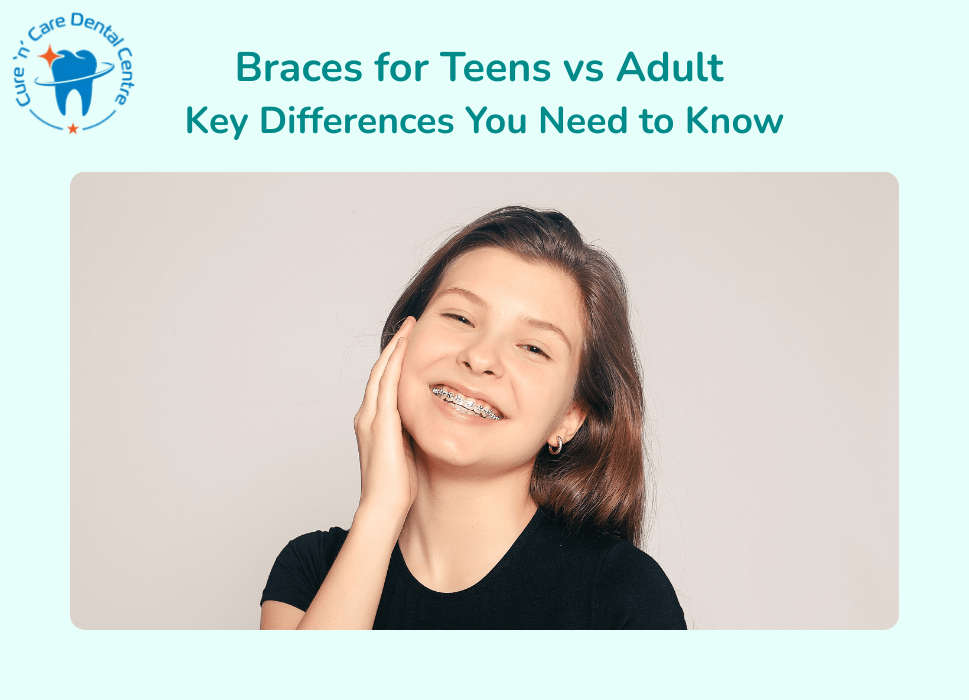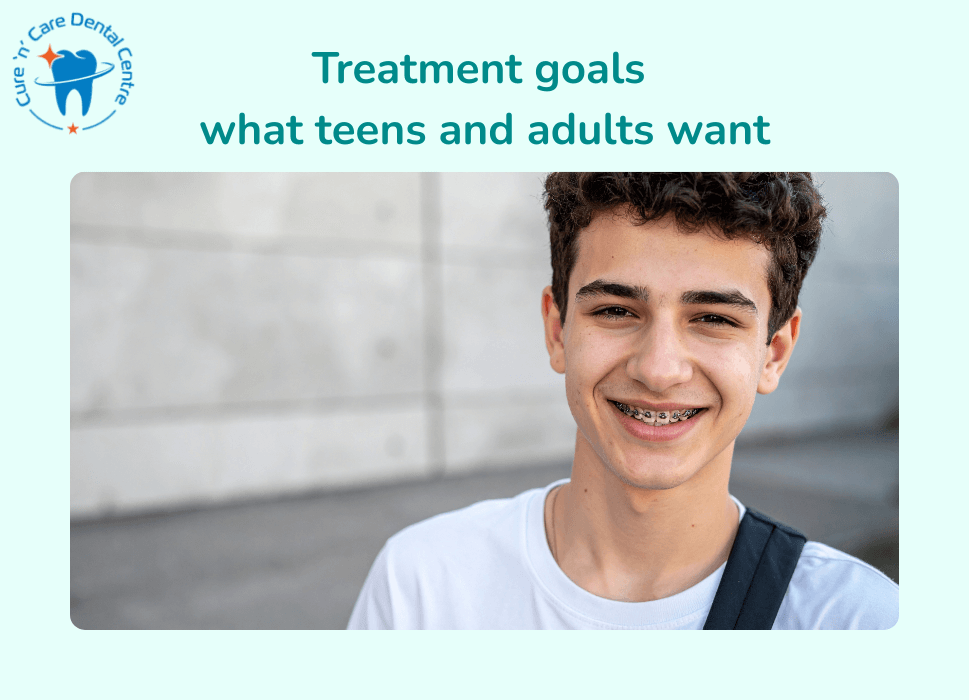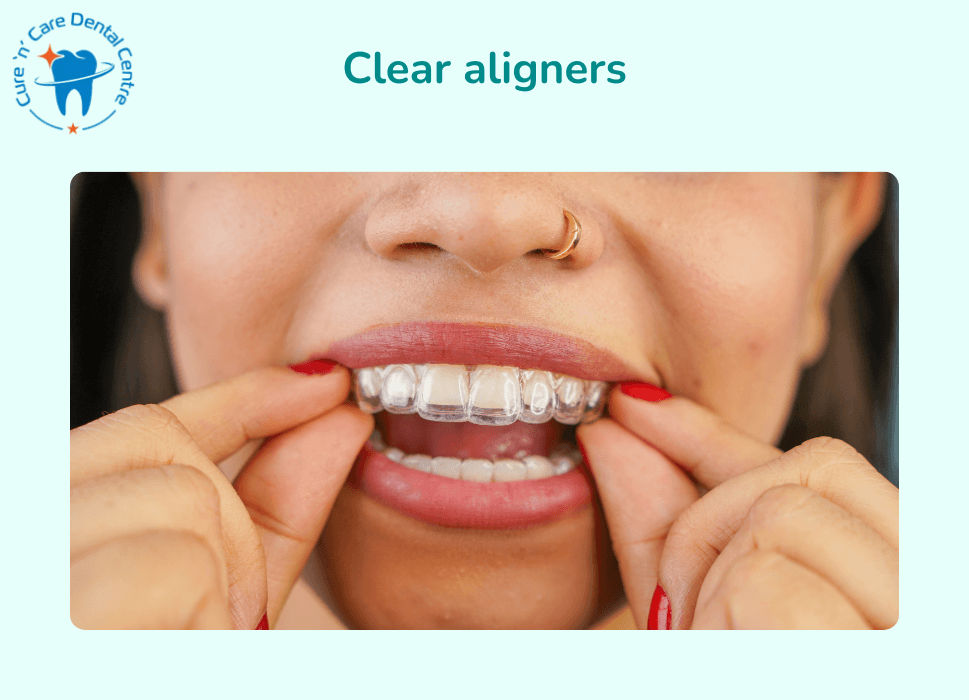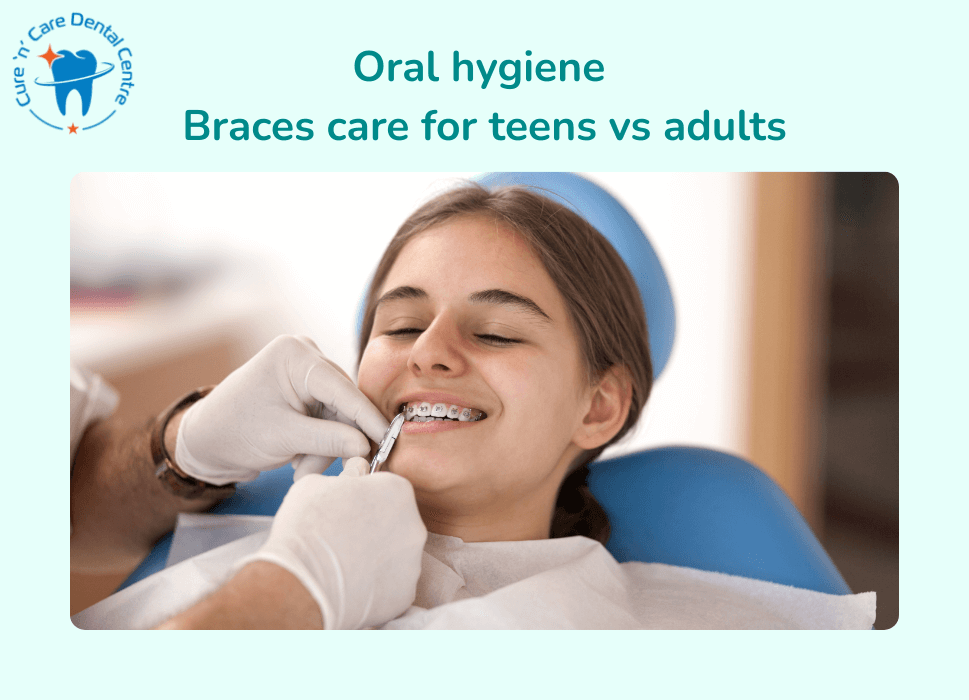
A confident smile can change how you feel, how others perceive you, and even how you perform in school, at work, and in relationships. Braces are one of the most reliable ways to correct alignment, bite issues, and spacing problems but treatment isn’t one-size-fits-all. Teen and adult orthodontic care can differ in important ways.
At Cure n Care Dental Clinic in Lahore, we treat patients of all ages. This guide is written for parents considering braces for their teenager and for adults deciding whether it’s too late to start treatment. We’ll cover the medical differences, treatment choices, expected timelines, cost considerations, and practical tips so you can walk into your first consultation well prepared.
Why Age Matters: Biology and Orthodontic Response
A fundamental reason teens and adults experience different orthodontic journeys is biology. Bone biology, growth potential, and gum health change over time and influence how teeth move.
Growth and Bone Plasticity
Teenagers are still growing. The jawbones and facial bones retain growth potential and are more biologically ‘flexible’. That means:
- Teeth move more predictably and often more quickly in adolescents.
- Orthodontists can sometimes use a teen’s natural growth (with appliances like expanders or headgear) to correct jaw relationships or widen an arch without invasive procedures.
- Complex skeletal malocclusions (where the jaw position is the main problem) might be easier to manage during growth.
For adults, skeletal growth is finished. Tooth movement is driven by remodeling of the bone around the roots, which happens more slowly in mature bone. As a result, treatment can take longer and may sometimes need adjunctive procedures (like minor surgery or the use of bite-correcting appliances) to achieve the best outcome.
Gum and Bone Health
Adults are more likely to have gum recession, periodontal (gum) disease, or reduced bone levels from past dental problems. Healthy gums and bone are essential for successful orthodontic movement. In adults, pre-existing gum disease often needs to be treated and stabilized before braces begin.
Teens typically have healthier gums (assuming good hygiene), which helps orthodontic treatment proceed smoothly. However, teens can also experience gingivitis if oral hygiene with braces is neglected.
Tooth Wear, Restorations and Missing Teeth
Adults often have more dental history like large fillings, crowns, wear, or missing teeth that can complicate orthodontic planning. Restorations may need to be replaced or adapted once teeth move. Missing teeth sometimes require orthodontics as well as restorative work (like implants) and careful timing.
Teens usually have fewer restorations and less long-term wear, making planning more straightforward.

Treatment Goals: What Teens and Adults Want
While both groups share the desire for a straight, healthy smile, the emphasis may differ.
Typical Goals for Teens
- Correct crowding and spacing
- Fix common bite issues (overbite, underbite, crossbite)
- Guide jaw growth (when indicated) to avoid future skeletal problems
- Achieve an attractive smile during formative social years
Parents and teens also often want a treatment that fits school schedules, sports, and social life.
Typical Goals for Adults
- Improve dental function and bite to reduce wear and jaw pain
- Enhance appearance (important for career and personal confidence)
- Close gaps or prepare spaces for dental implants/restorative work
- Address long-standing dental problems (e.g., teeth drifting after extractions)
Adult patients may also require interdisciplinary care (periodontics, prosthodontics, oral surgery) to address gum disease, missing teeth, or crowns.
Treatment Options and How they Differ By Age
There are multiple orthodontic options today from traditional metal braces to nearly invisible aligners. Age plays a role in which choices are best.
Traditional Metal Braces
- Best for : teens and adults with complex movement needs.
- Pros : Highly effective, versatile, lower cost compared with some alternatives, great for complicated tooth rotations and severe bite corrections.
- Cons : Visible; requires careful hygiene; occasional soft tissue irritation.
Metal braces remain the workhorse of orthodontics, especially when large or precise tooth movements are required.
Ceramic Braces (tooth-colored)
- Best for : image-conscious teens and adults who need fixed braces but want something less noticeable.
- Pros : Less visible than metal, effective for moderate to complex cases.
- Cons : Brackets are slightly larger, and ceramic ties can stain if not cared for; brackets can be more brittle.
Lingual Braces (behind-the-teeth)
- Best for : adults and older teens seeking a completely hidden solution.
- Pros : Virtually invisible from the front.
- Cons : Can be more uncomfortable initially, harder to clean, typically more expensive, may affect speech temporarily.
Lingual braces are less common but excellent for patients who prioritize aesthetics above all else.

Clear Aligners (e.g., Invisalign and Similar Systems)
- Best for : motivated teens and adults with mild-to-moderate alignment or spacing issues.
- Pros : Nearly invisible, removable for eating and cleaning, comfortable.
- Cons : Require discipline to wear 20-22+ hours per day; may not be suitable for complex cases; cost can be higher.
Clear aligners have become extremely popular among adults due to aesthetic appeal and convenience. Teen-specific aligner programs offer compliance features (like wear indicators) to help parents and clinicians track usage.
When Adults Need Combined Treatments
Because adults may have missing teeth or gum issues, their plan can include orthodontics + implants, crowns, or gum therapy. Coordination between orthodontist and other specialists ensures a predictable outcome.
Ready to get your teen a smile they deserve?
Book an orthodontic screening at Cure n Care Dental Clinic, Lahore. Our team will assess growth, bite, and orthodontic needs and explain the best options.
Book your ConsultationDuration: How Long Does Treatment Usually Take?
Treatment time depends on complexity, but age can influence the timeline.
Typical Teen Timelines
- Simple cases: 6–12 months
- Moderate cases: 12–18 months
- Complex cases: 18–36 months
Because teenagers’ bones are growing and more responsive, many cases finish at the lower end of these ranges compared with adults when similar complexity is involved.
Typical Adult Timelines
- Simple cases: 9–15 months
- Moderate cases: 12–24 months
- Complex cases: 18–36+ months (may include preparatory periodontal or restorative procedures)
Adults often need slightly longer treatment because bone remodelling is slower and certain movements (like root torque or closing spaces around implants) require careful, gradual force.
Compliance and Lifestyle: Different Challenges
Compliance matters for both age groups, but it looks different.
For Teens
- Teens might be less consistent with oral hygiene, wearing elastics, or avoiding forbidden foods.
- Peer pressure about appearance matters: ceramic braces or clear aligners may be preferred.
- Busy schedules (school, sports, tuition) mean appointments must be convenient.
Parents play a pivotal role in enforcing good hygiene and appliance wear.
For Adults
- Adults generally show higher motivation and discipline — they know the value of the investment.
- However, adults often juggle jobs, family, and social obligations. Night shift workers or frequent travellers may need scheduling flexibility.
- Adults may have to manage work meetings, social appearances, or public speaking while adjusting to braces; discreet options are popular.
6. Comfort and Pain: What to Expect
Both teens and adults experience soreness after adjustments or when starting a new appliance. The intensity is generally similar, though adults sometimes perceive discomfort more acutely because of denser bone and possibly higher sensitivity.
Ways to manage discomfort:
- Over-the-counter pain relief (paracetamol or ibuprofen as advised by your doctor)
- Soft diet for the first few days after placement or adjustments
- Orthodontic wax to reduce bracket irritation
- Cold foods and rinses to soothe tender gums

Oral Hygiene: Braces Care for Teens VS Adults
Good oral hygiene is crucial to prevent cavities, decalcification (white spots), and gum disease during orthodontic treatment.
Teen-Focused Tips (parents, take note)
- Teach and supervise brushing: 2 minutes, twice a day, focusing on brackets and wires.
- Use interdental brushes or proxy brushes to clean under wires and between brackets.
- Encourage flossing daily — floss threaders or interdental flossers make this easier.
- Consider fluoride toothpaste and mouth rinse to strengthen enamel.
- Keep sugary or sticky snacks to a minimum; braces-friendly snack lists help.
Adult-Focused Tips
- Follow the same routine rigorously — adults’ higher risk for gum disease makes this mandatory.
- If you have restorations (crowns, veneers), schedule checks to ensure margins remain sealed and healthy during tooth movement.
- Periodontal maintenance may be prescribed more frequently for adults with a history of gum disease.
A professional cleaning schedule at Cure n Care will be recommended based on your risk profile.
Aesthetics and Social Impact
Appearance concerns are common for both teens and adults, but they manifest differently.
Teens
- Braces are often seen as a normal rite of passage — many teens view braces as a social norm.
- Colorful elastics can even be a form of self-expression.
- That said, some teens do worry about teasing or photos; discreet options can help.
Adults
- Adults typically prefer less visible options due to professional and social considerations.
- Clear aligners, ceramic brackets, or lingual braces are popular for maintaining a polished appearance.
Cost Considerations: Teens vs Adults (and local context)
Costs can vary widely based on the chosen system, treatment complexity, and whether additional procedures (extractions, implants, periodontal treatment) are required.
Typical Cost Drivers
- Type of appliance (metal braces generally more affordable; lingual braces and aligners often cost more)
- Length and complexity of treatment
- Need for interdisciplinary work (oral surgery, implants, crowns)
- Geographic location and clinic reputation
At Cure n Care Dental Clinic in Lahore, we offer a range of affordable and premium orthodontic options. Exact pricing depends on your personalized treatment plan. We recommend scheduling a consultation for an accurate quote.
Risks, Complications and How they Differ by Age
Orthodontics is safe, but like any dental treatment, it carries potential risks.
Common Risks for Both Groups
- White spot lesions (decalcification) from poor hygiene
- Root resorption (shortening of tooth roots) — usually minor but monitored with X-rays
- Soft tissue irritation or ulcers
- Tooth sensitivity
Adult-specific Concerns
- Potential exacerbation of gum recession if aggressive tooth movement occurs in areas with thin gum tissue
- Higher chance of needing periodontal care before or during treatment
- When moving teeth into spaces with implants or where teeth are missing, prosthetic planning is necessary
Clinicians at Cure n Care will evaluate these risks and present a plan to minimize them, including collaboration with periodontists where necessary.
Retention: The Lifelong Part of Orthodontics
Braces move teeth into new positions — retention maintains that result.
Retainers and Recommendations
- Fixed (bonded) retainers : Thin wire bonded behind front teeth to maintain alignment. Often recommended for lower incisors.
- Removable retainers (Hawley or clear vacuum-formed) : Worn full-time initially, then at night.
Teens and adults both need retainers. The difference is that adults, particularly those with prior periodontal issues, may be advised to wear retainers long-term (often nightly for life) to avoid relapse.
At Cure n Care, we include retention planning as part of the treatment package and recommend a schedule tailored to each patient.
In Special Cases When Orthodontics is Combined with other Treatments
Both teens and adults sometimes need combined care:
- Orthognathic (jaw) surgery : Typically for severe skeletal issues. Teen candidates are assessed for growth completion; adults may be more likely to need surgical correction.
- Gum surgery or grafts : To strengthen thin gums before aggressive tooth movements in adults.
- Implants and prosthetic work : Adults with missing teeth may have implants placed after orthodontic alignment to create ideal spacing. Implants are generally not placed until growth is complete.
Interdisciplinary planning leads to the best functional and aesthetic results.
Practical Tips for Parents of Teens
Start early : The American Association of Orthodontists recommends a screening by age 7. Not every child needs braces early, but early assessment identifies issues that benefit from timely intervention.
Monitor oral hygiene : Help your teen establish thorough brushing/flossing routines and consider professional cleanings every 3–6 months if needed.
Choose appliances that fit lifestyle : For very active teens, consider bracket options and sports mouthguards.
Encourage responsibility : Teens who take ownership of their treatment often enjoy faster progress and better results.
Be patient and supportive : Regular appointments and occasional adjustments are part of the process.
Practical Tips for Adults Considering Braces
Be upfront about your timeline : If you have a special event (wedding, public speaking), discuss it with your orthodontist so treatment can be planned around it.
Clarify restorative needs : If you have crowns, veneers, or missing teeth, coordinate treatment early with your dentist.
Consider aesthetics : Discuss ceramic, lingual or aligner options if visibility is a concern.
Prepare for hygiene maintenance : You may need more frequent cleanings during treatment.
Ask about financing : Many clinics, including Cure n Care, offer payment plans to spread the cost.
Take the Next Step: Personalized Orthodontics for Teens & Adults
If you’re a parent deciding for a teen: early evaluation is key. Many problems are easiest to correct while growth is ongoing. However, waiting for full aesthetics can still be appropriate for many straightforward alignment cases.
If you’re an adult considering treatment: don’t assume it’s too late. Modern orthodontics has excellent options tailored for adults — from clear aligners to lingual braces. Ensure a full dental and periodontal evaluation before starting.
At Cure n Care Dental Clinic in Johar Town, Lahore, our team will create a personalized plan that considers your age, dental health, lifestyle, and expectations. Your smile is a long-term investment, one that pays back in confidence, function, and oral health.
Thinking it’s too late for braces? Think again.
A straight, healthy smile is achievable at any age with the right planning and care. Whether you’re helping a teen through treatment or seeking change for yourself, Cure n Care Dental Clinic in Lahore is here to guide you at every step.
Book your ConsultationFrequently Asked Questions
Is there an age limit for braces?
There is no upper age limit for orthodontic treatment if the gums and bone supporting the teeth are healthy. Adults who have gum disease will need periodontal treatment first.
Will braces be painful for my teenager?
Braces cause mild to moderate discomfort after placement and after adjustments, usually manageable with over-the-counter pain relief. Most teens adapt quickly.
Can adults get Invisalign instead of braces?
Yes. Clear aligners like Invisalign are a popular choice for adults with mild to moderate teeth alignment issues. They require strict wear time to be effective.
Will braces be painful for my teenager?
Braces cause mild to moderate discomfort after placement and after adjustments, usually manageable with over-the-counter pain relief. Most teens adapt quickly.
Can adults get Invisalign instead of braces?
Yes. Clear aligners like Invisalign are a popular choice for adults with mild to moderate teeth alignment issues. They require strict wear time to be effective.
How long do most orthodontic treatments take?
Treatment time varies by case complexity. Teens often complete treatment faster due to ongoing growth, but a typical range is 12–24 months for many cases.
Do braces damage teeth?
Braces themselves do not damage healthy teeth. Poor oral hygiene while wearing braces can cause decalcification (white spots) or cavities. That's why good hygiene is essentia
How often will my teen need appointments?
Typically, every 4–8 weeks for fixed braces. Aligners may require visits every 6–10 weeks.
What happens after braces are removed?
Retainers are used to preserve results. Your orthodontist will recommend the type and schedule for retainers.
How do I book a consultation at Cure n Care Dental Clinic?
A: Call our Lahore clinic or visit our website/contact page to book an appointment. Our team will guide you through the process and answer any questions.

